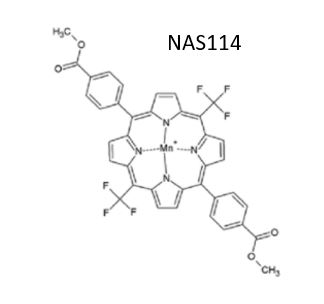Superoxide Dismutase Mimetics
A Class of Antioxidant Compounds
Our anti-inflammatory platform technology consists of compounds NAS150, NAS114, and NAS415 are all Superoxide Dismutase (SOD) mimetics. SOD is an enzyme that catalyzes the dismutation of the superoxide radical into oxygen and hydrogen peroxide. SOD mimetics “mimic” this native enzyme’s function and therefore have large therapeutic potential in the treatment of diseases where oxidative stress is involved.
NAS150 (formerly known as AEOL-10150) is our clinical-stage lead drug candidate, a small molecule catalytic antioxidant that has shown the ability to scavenge a broad range of reactive oxygen species (ROS), or free radicals. As a catalytic antioxidant, NAS150 mimics and thereby amplifies the body’s natural enzymatic systems for eliminating these compounds. Because excess generation of reactive oxygen, nitrogen and lipid species are believed to have an important role in the pathogenesis of many diseases, we believe that NAS150 can have a broad range of potential therapeutic uses.
 NAS150 has been shown to reverse multiple biomarkers of inflammation, oxidative stress, and immune response that are associated with DNA oxidative damage, fibrosis, and central nervous system dysfunction in animal models. New Amsterdam Sciences is focused on studying the compound as a potential therapeutic in Idiopathic Pulmonary Fibrosis (IPF), Progressive Supranuclear Palsy (PSP), and Radiation-Induced Lung Injury (RILI). Following the observation that NAS150 has been shown to be safe and well tolerated in 48 subjects in three Phase 1 studies, NAS150 is moving into Phase 1B/2A clinical trials for both IPF and PSP. NAS150 has Fast-Track Designation from the FDA for Lung Acute Radiation Syndrome.
NAS150 has been shown to reverse multiple biomarkers of inflammation, oxidative stress, and immune response that are associated with DNA oxidative damage, fibrosis, and central nervous system dysfunction in animal models. New Amsterdam Sciences is focused on studying the compound as a potential therapeutic in Idiopathic Pulmonary Fibrosis (IPF), Progressive Supranuclear Palsy (PSP), and Radiation-Induced Lung Injury (RILI). Following the observation that NAS150 has been shown to be safe and well tolerated in 48 subjects in three Phase 1 studies, NAS150 is moving into Phase 1B/2A clinical trials for both IPF and PSP. NAS150 has Fast-Track Designation from the FDA for Lung Acute Radiation Syndrome.
NAS114 (formerly known as AEOL-11114) is a development-stage compound, also a small molecule catalytic antioxidant that has shown the ability to scavenge a broad range of reactive oxygen species, or free radicals. As a catalytic antioxidant which can also mimic catalase (thus driving neutralization of hydrogen peroxide) and scavenge lipid peroxides and peroxynitrates, NAS114 amplifies the body’s natural enzymatic systems for eliminating these damaging compounds. It is orally bioavailable and can better access the brain to treat CNS diseases.
 In CNS studies, NAS114 has been shown to have an effect in reducing neurodegeneration and reducing oxidative stress markers in mice and rats. NAS114 mitigates depletion of the neurotransmitter dopamine and prevents loss of nigrostriatal dopaminergic neurons, which are the most important pathological features of Parkinson’s Disease patients. Not only is NAS114 able to penetrate the blood brain barrier, but it is stable in human plasma and shown to be safe after 28-day administration. New Amsterdam Sciences is looking at how the compound can affect CNS disorders like Parkinson’s Disease and Epilepsy. To date, NAS114 has shown to be safe and protective of neurodegeneration in animal models. Considering Reactive Oxygen Species (ROS) are known to be a therapeutic target for Parkinson’s Disease, catalytic scavengers of ROS like NAS114, have been shown to be neuroprotective and extremely promising treatments for this disease.
In CNS studies, NAS114 has been shown to have an effect in reducing neurodegeneration and reducing oxidative stress markers in mice and rats. NAS114 mitigates depletion of the neurotransmitter dopamine and prevents loss of nigrostriatal dopaminergic neurons, which are the most important pathological features of Parkinson’s Disease patients. Not only is NAS114 able to penetrate the blood brain barrier, but it is stable in human plasma and shown to be safe after 28-day administration. New Amsterdam Sciences is looking at how the compound can affect CNS disorders like Parkinson’s Disease and Epilepsy. To date, NAS114 has shown to be safe and protective of neurodegeneration in animal models. Considering Reactive Oxygen Species (ROS) are known to be a therapeutic target for Parkinson’s Disease, catalytic scavengers of ROS like NAS114, have been shown to be neuroprotective and extremely promising treatments for this disease.
Funding for studies conducted on these compounds have been sourced by various highly-respected organizations such as: National Institutes of Health (NIH), Biomedical Advanced Research and Development Agency (BARDA), The Michael J. Fox Foundation, Cystic Fibrosis Foundation, and Citizens United for Research in Epilepsy (CURE) Foundation.
Covid Hot Spots
© 2020 New Amsterdam Sciences | Terms of Use | Privacy Policy | Contact Us
